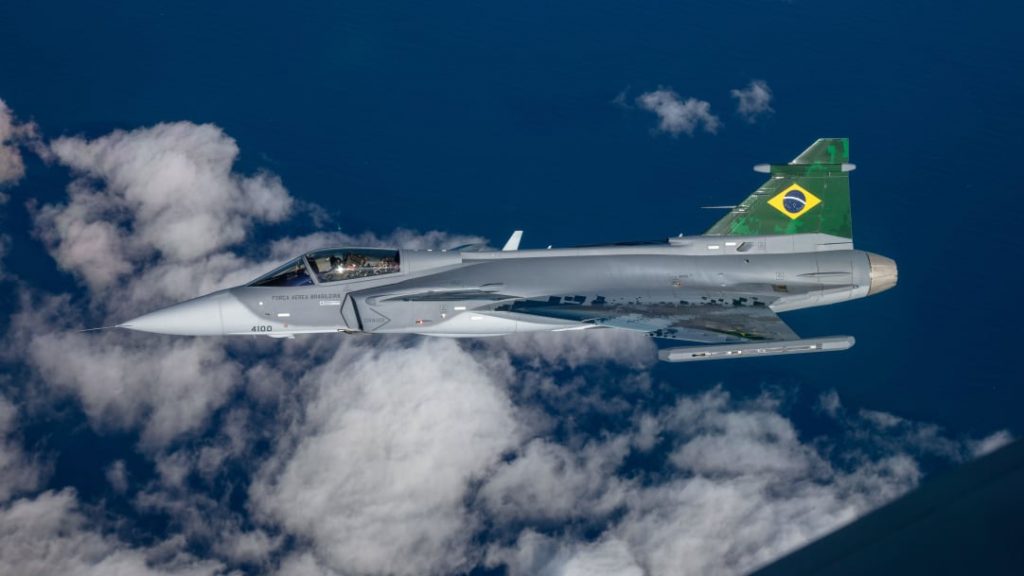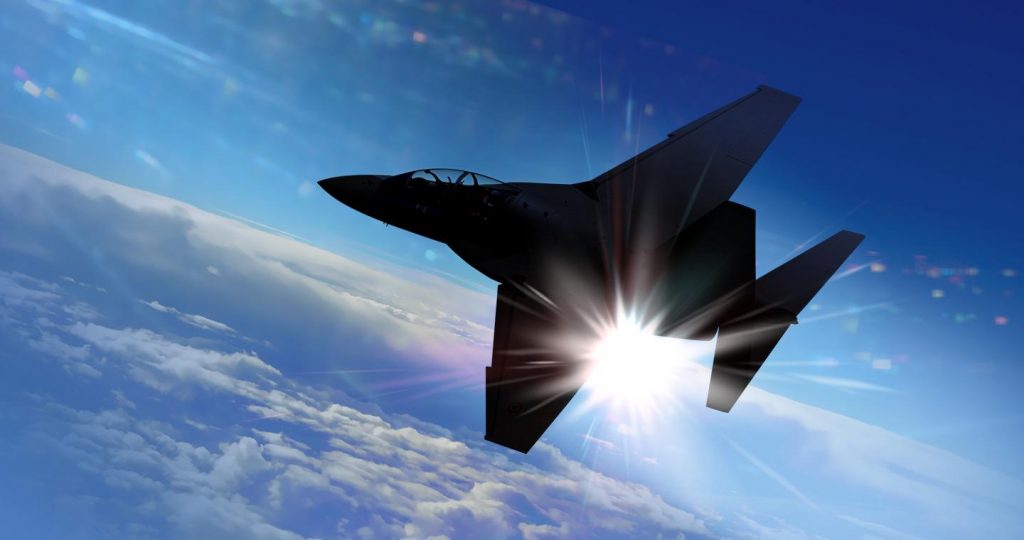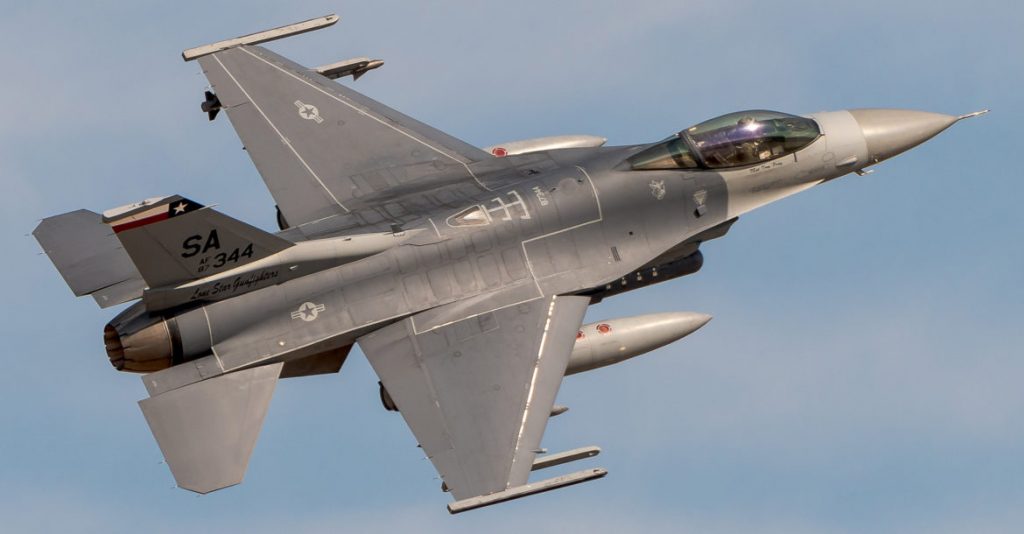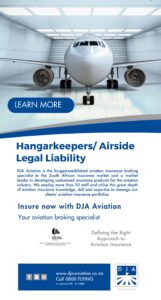Monthly Archives: October 2020
Saab strengthens ties to Quebec and Canada through CRIAQ partnership
This collaborative relationship aims to leverage Quebec’s R&D ecosystem’s strengths to encourage the development of collaborative research projects between Saab and Canadian industry, as well as universities and research organizations.
This collaboration has been formed to support Saab’s future Industrial and Technological Benefit (ITB) commitments, if the Gripen fighter is selected for Canada’s Future Fighter Capability Project (FFCP).

“The quality and breadth of aerospace research and innovation in Canada is globally recognised, with the Quebec region home to many excellent companies and institutions. Therefore, it was natural to reach this agreement with an important organisation like CRIAQ. We look forward to working together to benefit research and the fostering of talent in Quebec,” said Jonas Hjelm, Senior Vice President and Saab’s Head of business area Aeronautics.

“During such unsure times within the industry, this partnership demonstrates that the aerospace industry in Quebec and Canada remains attractive and world class. We are very pleased with this signing as we continue to develop our aerospace industry, adding a new global player to our ecosystem. I am convinced that CRIAQ’s academic, industrial and SME community, and the Quebec economy as well, will clearly benefit from this international collaboration,” said Alain Aubertin, CEO of CRIAQ.

The ITB Policy is the government’s main tool for leveraging procurement to create jobs and economic growth in Canada. Saab has submitted an offer of 88 Gripen E fighters for the Canadian FFCP, and a core element of the Gripen industrial offering includes CAE in Montreal, Quebec who will supply training and mission systems solutions.
C-390 Millennium receives Aviation Week Grand Laureate in the Defense Segment
São Paulo, Brazil, October 19, 2020 – The Embraer C-390 Millennium multi-mission aircraft, manufactured by Embraer, today received the Grand Laureate in the Defense Segment and the Laureate Award for the “Best New Product” in Defense from Aviation Week Network. The citation for the award reads, “The first C-390 tanker/transport, the largest and most sophisticated aircraft yet developed by Embraer, was delivered to the Brazilian Air Force in 2019.”
“To receive an award with as much prestige as the Laureate is a very significant acknowledgement of the exceptional work of all Embraer employees. This is a substantial recognition of the merits of our engineers and the ability of our workforce to execute the development of such an advanced product with excellence,” said Francisco Gomes Neto, Embraer S.A. President and CEO. “Embraer’s new business strategy seeks to increase revenue and profitability, and the C-390 Millennium plays an important role in solidifying the Company as a serious entrant in a new market segment.”

“We are honored to receive this award, which recognizes the excellence of our programs and of this aircraft, which was developed to set new standards in its class, bringing exceptional performance complemented by the lowest life-cycle cost in the market,” said Jackson Schneider, President and CEO of Embraer Defense & Security. “The C-390 Millennium offers greater flexibility and value to operators performing air transport and air mobility missions, among others.”
The Aviation Week Laureates Awards recognize the extraordinary achievements and innovative personalities that represent the values and vision of the global aerospace community. Programs honored with Laureates Awards have changed the way people work and move around the world. Aviation Week continues to recognize the very best accomplishments in the four pillars of our industry: Defense, Commercial Aviation, Space, and Business Aviation.

In 2009, the Brazilian Air Force (FAB) contracted Embraer to design, develop, and manufacture the C-390 Millennium aircraft as a replacement for its aging C-130 fleet. Deliveries to FAB started in September 2019. The C-390, which was recently ordered by the Portuguese Government, is a new generation multi-mission transport aircraft that offers unrivaled mobility, fast reconfiguration, high availability, and enhanced flight safety, all on a single, exclusive platform.


The aircraft can perform a variety of missions, such as cargo and troop transport, cargo and paratrooper airdrop, aerial refueling, search and rescue, aerial firefighting, medical evacuation, and humanitarian missions.
Flying faster and delivering more value, the Millennium is the right sized platform for major airlift deployment scenarios. Minimized intervals and on condition maintenance, combined with highly reliable systems and components, reduce downtime and costs, contributing to outstanding availability levels and low life cycle costs.

The C-390 benefits from a modern fly-by-wire flight control system with integrated technology that lowers the workload of the crew and increases the safety of its operation. Furthermore, the aircraft can refuel other aircraft in flight, with the installation of removable internal fuel tanks. The aircraft can also be refueled in flight, thus providing greater flexibility for longer missions. An advanced self-defense system increases the aircraft’s survival capability in hostile environments.

Equipped with two International Aero Engines V2500 turbofan engines, the latest avionics, a rear ramp, and an advanced cargo handling system, the C-390 is capable of carrying up to 26 metric tons of cargo at a maximum speed of 470 knots (870 km/h), with ability to operate in austere environments, including unpaved or damaged runways. The aircraft can carry troops, pallets, armored wheeled vehicles, and helicopters.

Aviation industry tests a key solution to fly seamlessly and with more efficiency in Europe
- The COVID crisis underpins the urgency for Europe’s aviation industry to push ahead with delivering the future Digital European Sky, and building a smarter, more sustainable and resilient system in the long term.
- An essential component of the future system is ground-to-ground interoperability, a solution designed to enable the swift and seamless exchange of flight trajectory information in real time between Europe’s network of 63 air traffic control centres.
Europe’s aviation industry has completed the final test of a new SESAR Solution on ground-to-ground interoperability, which is designed to allow the network of 63 European en-route control centres to exchange information on the flight trajectories in real time, thus supporting seamless operations and improving flight efficiency.

This milestone has been reached at a time of unprecedented crisis, due to the COVID pandemic, which is compelling the industry to push ahead with delivering the future Digital European Sky, in support of a smarter and more sustainable recovery in the long term.
Air navigation service providers in Germany (DFS), France (DSNA), Spain (ENAIRE), Italy (ENAV) and EUROCONTROL’s Maastricht Upper Area Control Centre (MUAC), together with the technology provider manufacturing industries Indra, Leonardo and Thales, have worked together on its development, within the context of the SESAR Joint Undertaking research and innovation programme (SESAR 2020).

This solution addresses a frequent problem that affects Europe’s air traffic, whereby flights crossing borders or different airspace sectors have to adjust their trajectory or speed to avoid conflicts with other aircraft. The problem is caused largely by en-route control centres sharing information in a sequential way and updating the trajectory information.
To address this situation the SESAR JU ‘4DTM’ ground-to-ground interoperability (IOP) project, coordinated by Indra, has developed a solution that allows the sharing of information in real time.

With this solution, control centres involved in the management of a flight can share reliable, complete and updated flight trajectory information from take-off to landing, taking into account any existing and shared internal restrictions in the airspaces that the flight will cross.
Final tests of this solution – following the first trials successfully held in April 2019 – took place last June during two weeks in an environment simulating the operations of the Maastricht UAC, Reims UAC, Karlsruhe UAC, Geneva and Zurich UACs, Padua and Milan UACs.

Thanks to the IOP solution, all actions carried out in one centre are immediately visible in all other centres, removing any uncertainty over the conditions under which a flight would enter another airspace.
The end goal is to attain a smoother control process, which will improve the efficiency of air traffic control in Europe and make it possible to manage more flights with greater precision and punctuality, offering cost savings to airlines, reductions in CO2 emissions and ultimately providing a better service for passengers.

The solution will also help carry out the ATC process “quietly”, without the need for the air traffic controller to coordinate with his/her counterparts in adjacent centres by phone. For this purpose, and implementing the “flight object” concept, all control centres share the same information and have the possibility to request changes to flight trajectories in real time.
Some use cases on which the solution was tested:
- Changes in flight level requested by the aircraft in order to avoid storms Route changes requested by the aircraft in order to shorten route
- Real-time updates on the information regarding a particular flight trajectory by using the Flight Object data
- Flexible flight transfer procedures between control centres
- Flight management coordination between centres
- What-if mechanism to preview and negotiate changes
IOP is the enabling ground-ground communication technology and protocols for seamless flight operation across regions and national boundaries, and underpins the 4D flight trajectory with the real-time sharing of the trajectory among all the ATM actors
The results of these tests will be released at the end of this year, and will be used to update the ED133 standard developed by the European Organisation for Civil Aviation Equipment (EUROCAE), which will support subsequent industrialisation and implementation.
Scalable Agile Beam Radar (SABR) upgrades continue for US Guard, reserve and active-duty fighters
BALTIMORE – Oct. 15, 2020 – The U.S. Air Force has met Full Operational Capability (FOC) readiness for Northrop Grumman Corporation’s (NYSE: NOC) AN/APG-83 SABR active electronically scanned array (AESA) radar on Air National Guard F-16s to meet a U.S. Northern Command Joint Emergent Operational Need (JEON) for homeland defense.
On Sept. 7, the U.S. Air Force began installation of APG-83 radars on Air National Guard F-16s at Joe Foss Field, Sioux Falls, South Dakota, the fourth U.S. Air Force base to receive AN/APG-83 SABR AESA radar upgrades.

The radar upgrade of Air National Guard F-16s extends the operational viability and reliability of the fleet while providing pilots with 5th-generation fighter radar capabilities to defend our nation’s airspace.
“SABR enables F-16 pilots to detect, track, identify and target a greater number of threats faster and at longer ranges from outside the threat envelope,” said Mark Rossi, director, SABR programs, Northrop Grumman. “This upgrade will keep the multirole F-16 fighter relevant and capable for decades to come.”

The AN/APG-83 features all-weather, high-resolution synthetic aperture radar mapping to present the pilot with a large surface image for more precise target identification and strike compared to legacy systems. Its design incorporates proven hardware and advanced operating modes from Northrop Grumman’s fifth-generation F-35 and F-22 AESA radars. The high degree of commonality and shared manufacturing processes and infrastructure drives efficiencies and affordability improvements across all of Northrop Grumman’s AESA radar programs.
The AN/APG-83 AESA is now an official program of record for both the active and reserve U.S. Air Force as well as the Guard after the service procured units in February for Air Combat Command and Air Force Reserve F-16 aircraft.

Northrop Grumman solves the toughest problems in space, aeronautics, defense and cyberspace to meet the ever evolving needs of our customers worldwide. Our 90,000 employees define possible every day using science, technology and engineering to create and deliver advanced systems, products and services.
Joe Ford joins Draken International as Chief Executive Officer
Las Vegas, NV – The Board of Directors of Draken International, LLC has elected Joseph “Joe”Ford as Chief Executive Officer, effective immediately. Ford will also serve as a member of the company’s Board of Directors.

Ford previously served as President, DynAviation at DynCorp International. At DynAviation, Ford was responsible for all aspects of the segment’s profit and loss performance with functions including operations, supply chain management, finance, quality assurance, human resources, contracts and internal and external business development.

Ford will succeed Jared Isaacman who has served as Draken’s Founder and Chief Executive Officer since 2011. Isaacman will become the non-executive Chairman of the Board of Directors and will assist Ford through the transition.

“During a period of tremendous growth for our company and the commercial adversary air industry, there is no better person to lead Draken International,” stated Isaacman. “After serving
his country with distinction for 25 years and growing defense companies that support the U.S. military, Joe has the leadership, strategic vision and record of execution to fly Draken to new heights. His insight for how to apply modernization to our comprehensive fleet of fighters will prove beneficial and is exactly what Draken needs as the company enters its next
chapter of expanded growth.”
“I am beyond thrilled to join the Draken family,” stated Ford. “I understand the need to provide the U.S. military aviation community with the readiness it needs while making every taxpayer dollar go further. Draken is the best in the business and I am honored to have Jared and the Board’s support as we remain focused on supporting our nation’s military aviators every day.”
Before his career in the private sector, Ford had a distinguished military career, retiring from the U.S. Air Force as a Colonel in January of 2007 as the commander of the 401st Air Expeditionary Wing at Aviano Air Base, Italy.
Other roles during his military career include commander of the
18th Operations Group at Kadena Air Base, Japan and commander of the 35th Fighter Squadron at Kunsan Air Base, South Korea. Mr. Ford is a combat veteran with four fighter deployments to
the Middle East. His aviation career includes over 4,000 hours in aircraft including the F-4C/D,A-7D, F- 117, F-16A/B/C/D, F-15C/D, HH-60, E-3 and KC-135R.

“Draken is the kind of mission driven company with which we like to partner,” said Todd Hirsch, Senior Managing Director at Blackstone Tactical Opportunities and a member of the company’s board. “A decade ago, Draken was an idea – that commercial adversary air support
can improve readiness and reduce sustainment and training costs for the U.S. Armed Forces.
Today, Draken is the industry’s leading provider of military aviation readiness training,completing over 20,000 flight hours with a fleet of more than 100 mission capable aircraft.

Under Joe’s leadership, it will continue to set the standard in airborne adversary support, flight training, threat simulation, electronic warfare support, research, testing, as well as other missions
uniquely suited to their fleet of aircraft.” Hirsch continued: “On behalf of the rest of the board and all our employees, we thank Jared for
creating this industry leading firm and guiding it so well. We are grateful to continue to have him as a partner.”

The board also elected Bill “Sweet” Tart as Chief Operating Officer. Sweet joins Draken from DynAviation where he was Senior Vice President, Business Development. Prior to his private sector career, Sweet served in the United States Air Force for 25 years, retiring in 2014 as the Director of the Remotely Piloted Aircraft Division at the Pentagon. He previously served as the commander of the 432nd Operations/Expeditionary Operations Group at Creech Air Force Base, Nevada and the senior military assistant to the Assistant Secretary of Defense for Legislative Affairs. Sweet is a Risner Trophy winner for outstanding performance at USAF Weapons
School.


Draken International is the world’s largest operator of ex-military aircraft. With over 100 tactical fighter aircraft incorporating modern 4th generation capabilities, the company is the partner of choice to support the growing global demand for commercial air services. Draken
employs world class, military trained fighter pilots including USAF Weapons School Instructors,Fighter Weapons School Graduates, TOP GUN Instructors, Air Liaison Officers, and FAC-A Instructors. In 2019, funds affiliated with Blackstone Tactical Opportunities completed a strategic investment into Draken International to facilitate the next phase of modernization and growth.
FlySafair,one of few that survived COVID
FlySafair seems to have been one of the few that survived our initial COVID impact…
By Niel Swart
As South Africa is slowly getting use to the new normal and these “unprecedented times”, we still often still hear “you are on mute” but through it all, some companies are doing well. Safair being one of them. We thought it is good to check in with Kirby Gordon after our initial Q&A session a while ago.
ZS-FGC on her first visit to Cape Town International
FlySafair seems to have been one of the few that survived our initial COVID impact, well done on that. How did you manage to do this under so many restrictions?
“Thanks. We’ve just continued to do what we always do – keep our costs as low as possible and try to offer the best service we could under the circumstances.”
FlySafair has not only survived, you have actually taken most of the market share. This is very good for business but is this good in the long run? What effect does the lack of competition have on an airline such as FlySafair?
“No it’s not great in the long-run as any healthy market needs competition. We look forward to the return of our competition to the market. More choice is good for consumer demand.”
A new airline is set to take flight end November 2020. Their fleet will have much larger aircraft and it is to be expected that they will start with domestic operations first. They are also saying they will be the cheapest in the market. Does this have an impact on your future plans as at first passengers may be drawn by the cheaper prices?
“Ours is a highly commoditised market and the supply and demand dynamics of the market are always going to be a factor to contend with. We’ve competed against airlines bigger than us, and some who enjoy state subsidies. We’re just going to do the best we can.”
Apart from taken most of the market share, you are also expanding. We noted there is a big employment drive for flight deck and cabin crew. Is this to cope with the demand that there is now but also keeping the future in mind?
“We are recruiting crew at the moment, not sure we would call it a big recruitment drive relative to previous efforts, but we do have some new aircraft arriving and need to crew them. Some of the recruitment under way is also to fill one or two positions of folks who have moved on to other things.”
With many domestic airlines having difficulties and staff being made redundant, is there an opportunity for those that want to, to move over to FlySafair?
“We are recruiting at the moment so there are a few positions available yes.”

Credit: Billy Botha FlySafair Technician – The latest addition to the fleet ZS-FGD still carrying her other registration N268WT
Not only are new employees on the cards, so are new additions to the fleet. We already have seen ZS-FGC being in operation and ZS-FGD is about to arrive this week. Are more aircraft expected? If so, how many?
“Yes, ZS-FGD arrived last Thursday (1 October 2020) and is awaiting licensing by the SACAA.”
Speaking of ZS-FGC, she has a special livery. Can you maybe tell us a bit more about it and the award you have won (congratulations!)?
“Thanks – yes, we painted her up to celebrate our award of Aircraft Operator of the Year at the Annual SACAA Excellence Awards evening. It was a great honour to be awarded this top spot and we obviously wanted people to know about it.”
On ZS-FGC and ZS-FGD we noted they have the Scimitar Winglets. Scimitar Winglets seem to be gaining popularity in South Africa. They are very costly but have up a fuel saving of up to 2.2%. Is this to bring down price tickets or perhaps to extend the range, maybe looking at international flights?
“Yes they do both have the winglets. We’re going to be monitoring the saving on them – these savings are always great on paper but the key is to identify what kind of difference they really make when you start to apply them to your specific network on your specific operating conditions. Theoretically the saving should be good on slightly longer hauls, but at this stage we’re going to fly a while and measure the differences to see whether it’s worth deeper investment.”
SAA (Mango branded) have been leasing B738’s from Safair. Have they been returned to Safair and are they now part of the fleet?
“There are a few B738s in our fleet that were once in the Mango fleet – I stand to be corrected but I think the first three 800s we brought in were all ex-Mango.”
How big is the fleet now and how many aircraft are leased vs owned?
“The FlySafair fleet is up to 17 now. We own the 8 400s.”
We noted the FlySafair fleet is only Boeing and the B737. Why the B737 and not the A320NEO?
“Key to the classic low cost operating model is to operate one type. We even stretch that rule a bit between the 400s and the 800s as it is, but the idea is to create efficiencies in terms of training, aircraft “swopability” and of course spares and maintenance. Safair had long been operating and maintaining Boeings before FlySafair was even a consideration, so the choice there was a pretty obvious one for us.”

Credit: Billy Botha FlySafair Technician – The latest addition to the fleet ZS-FGD
Will FlySafair always stick to Boeing or will other manufactures such as Airbus be incorporated later?
“No, the idea for the moment is to stay true that Low cost model in FlySafair and focus on one type.”
On the topic of the total fleet: previously we mentioned the Herc operations. How is that side of the business?
“Great. The Herc contracts operate very essential services on their contracts, so work fortunately continued through lockdown, which was a real help.”
We had a look at the age of the Hercs (to compare those to the ones owned by SAAF and we all looooooooooove a Herc) and noted the Hercs are aging. How many years will these iconic aircraft still be in service with Safair? If less than 5 years, what are the options being considered to replace the Hercs with?
“Your observation is accurate and very sad. Those aircraft have a remarkable legacy and it’s tragic to see them being slowly retired. We’re looking at a number of alternatives and engaging our clients in options that they might be interested in, but we’ve not committed to anything yet.”

Credit: FlySafair
Is the employment drive for flight and cabin crew to staff these new additions to the fleet?
“Yes and to a smaller degree to replace one or two staffers who have moved onto other careers.”
Are any aircraft due to leave the fleet, like the B734’s? If so, which ones and where are they heading to?
“Not in the immediate future.”
While on the topic of aircraft, as the fleet grows, so does the technical needs. As you are servicing aircraft yourself, do you foresee that even in this area more people will be needed?
“Possibly. We’ve certainly needed some more space and we’ve moved from occupying one hangar to three.”
Could it be that Cape Town also gets a technical facility or possibly even Safair hangars where full A, B or C checks and other heavy maintenance?
“Not at this stage.”
As FlySafair grows, how will you ensure that passengers and employees do not become just numbers and more business focussed compared to the more fun and personal airline we all love? Or differently put, how will you keep the small personal touch while being a large airline?
“That’s a big focus that we have and something that we work very hard on. It’s a particular challenge in the aviation space just by the sheer structure of airlines, specifically having your crew and your outstations geographically separated from the rest of your organisations. We make a big effort to ensure that everyone keeps close through a number of initiatives.”
We all hope we are over the worst when it comes to COVID-19 but what if a second wave is to hit us? What preparations are being made by FlySafair to withstand another possible lockdown?
“Yes, hopefully the worst is over, but we do need to be realistic about a possible resurgence. We’ll have to access the specific situational factors but we’re most likely to pursue a similar strategy to what we used the first time – seems to have worked for us so far.”
COVID19 has taught all industries various lessons. Which were the biggest lessons that Safair have had? Did any of these lesson have long lasting impact on how you will operate in future? As an example the check-in process at the check-in desks.
“One thing that our customers are really loving is the controlled disembarkation procedures where we work row-by-row, so we’ll definitely stick to that. The other thing that’s been key is refining our self-service offerings – so for example our existing Whatsapp boarding passes were a real asset but we’ve now had more opportunity to highlight those facilities and get more people to try them out.”
Will we maybe see a masked FlySafair special livery at some stage?
“Hahah, maybe, although it’s been done now – we like to be the first to do new things.”
Speaking of FlySafair maybe doing a masked livery, what community initiatives are Safair doing in these times of need?
“To be very honest, our focus has very much been internal now. We have a few external projects that we run, which have continued – things like our cadet program and work creation initiatives, but we’ve turned a lot of our focus on to looking after our own people who’s had to make sacrifices during this tough time. As they say, charity begins at home.”
On brand awareness: could we maybe see FlySafair/Safair participation at air shows next year? Past air shows have been dominated by Mango.
“It’s always something to consider but to be honest, the cost of involvement versus the marketing return is doesn’t add up. If we participated we’d do it more on the basis of engaging with staff, but they are expensive exercises.”
Could FlySafair in future sponsor an acrobatic flying team?
“Not likely – at the moment we are pretty dedicated to our springbok sponsorship and aren’t in the market for any new properties.”
Will the Birthday Sale return in 2021?
“Hopefully, but we’ll have to wait and see.”
Since our Q&A session with Elmar, he has been elected Airlines Association of Southern Africa’s (AASA) as their new deputy chairperson with Wrenelle Stander, CEO of Comair, as the new chairperson at its 50th annual general meeting. Congratulations to both, who will serve for the next 12 months, and we wish them all the best!
Book your FlySafair flight here
COVID Aviation Trips – Rand Airport
By now most of us have been absolutely deprived of aviation. Unfortunately all airshows for 2020 have been either postponed or cancelled. This leaves us with almost no aviation action, or does it?
In the coming weeks, we will be looking at different smaller aviation spots that can help scratch that aviation itch that has been annoying us all during this lockdown.
In the third installment in this series we are looking at yet another smaller airport in Gauteng. Rand Airport is a great spot to feel the wind coming off aircraft and smell the turbine exhaust.
What makes Rand great is the fact that it has more than one great spots. The first of these being the SAA Museum located at the Eastern side of the airport.
The museum has many historic SAA aircraft like 737s, DC-4s and 747s where one can get the opportunity to not only admire them from the outside, but also from within.


At the museum one can also find the Dakotas Pub and Grill. From the restaurant one has a nice view of Runway 29 takeoffs and landings as well as some taxiway action.
The second spot at Rand Airport is another Harvard Cafe. Just like the one at Grand Central, this restaurant offers a nice view of the apron, with great food and a play area for children.
Rand Airport is home to many beautiful aircraft like the Flying Lions, Cows Pitts, Goodyear Eagles, Menno Parsons’ collection and many more.







This airport makes for another great outing during these times where aviation seems to be a scarcity. With the SAA Museum and Harvard Cafe one can easily get two unique trips out of this one spot.
SAAF 75 best Airshow in Southern Africa to date?
Pictures by Stefaan Bouwer
The flightline at Airforce Base Waterkloof in Pretoria during the early week of October 1995 saw a number of visiting military air arms from across the world, attended what was South Africa’s biggest military Airshow to date!

This was also the the 75th Birthday celebrations of the South African Air Force. A number of aircraft were painted up in special paint schemes for the celebration, including the SAAF Museums Mirage IIICZ “Black Widow”.

From the biggest Antonov A124 which brought a number of Russian Fighter jets in the back of the hold, including a Mig 29 and SU35. Both flying and on static display!


The Americans brought out all their bells and whistles including an F16, F15, KC135R Stratotanker, C130s, Lockheed C-141 Starlifter and many more!

Australia brought out a P-3 Orion and the Canadian Airforce attended with a Boeing 707.The Royal Airforce were here with the famous Red Arrows, C130, and a E-3 Sentry.

The South African Air Force put on a excellent variety of both new and old, including the Mirage F1AZ flown by Chris “Piranha” Pretorius, which he got struck by lightning during one of his solo displays during the show. It was one of the last shows the Impala MK1s being the Silver Falcons before being replaced by the then new Pilatus PC7 MkII “Astra”.


One has to ask will we ever see a show as big as this one day again?














































































